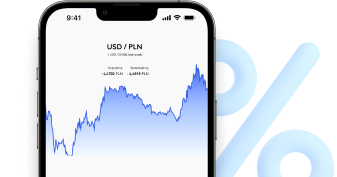Exchange rate CHF - Swiss franc
The franc is the currency of Switzerland and Liechtenstein. The smaller denomination, a hundredth of a franc, is a Rappen (Rp.) in German, centime (c.) in French, centesimo (ct.) in Italian, and rap (rp.) in Romansh.
Select currencies and check rates
Live rates.
Update: 30s
| Currency | Buy | Sell | Name | Currency code |
|---|---|---|---|---|
| CHF EUR | 1.0415 | 1.0488 | Swiss franc | 1 CHF |
Swiss franc exchange rate - chart
Last currency comments
Over 900 000 reviews
Customers rate us 4.9/5.0.*
Start saving today
Forget about unfavourable rates and hidden fees. See how much you can save. Create a free account and start converting currency online.
Open account for freeThe Swiss franc
Although valid in only two countries, the Swiss franc is considered one of the most influential currencies in the world. Everything thanks to the CHF exchange rate, which is well-known for its great stability.
The Swiss franc - where is it used?
Although the CHF is known worldwide and is often considered a safe haven, in reality, it is only valid in two countries. The Swiss franc is used as an official means of payment only in Switzerland and Liechtenstein. Residents of the Campione d'Italia enclave also accept it. Therefore, before travelling to these parts of the world, it is always good to check the Swiss franc exchange rate.
The history of the Swiss franc
The forefathers of the Swiss franc were the Helvetic franc, which functioned for a very short time (1789-1803), and the old Swiss franc of 1819. The origins of the Swiss currency, however, can be traced back to 1850. For many years it was closely linked to the French franc, with which it formed the Latin Monetary Union. The Franco-Prussian War made the Swiss realize that dependence on another country's currency could be dangerous. Long-lasting changes began that resulted in the debut of a new currency, the Swiss franc, following the Swiss National Bank's origin in 1907.
The Swiss franc - key information
The Swiss franc (CHF) is subdivided into 100 centimes (French name) or 100 rappens (German name). CHF coins are circulating in denominations of 5, 10 and 20 centimes and ½ franc, 1 franc, 2 francs and 5 francs. The obverse of centimes depicts a woman's head, francs - a woman with a shield, and in case of 5 francs - a bust of a man. The banknotes come in denominations of 10, 20, 50, 100, 200 and 1000 CHF. Their distinctive feature is not only their bright and vivid colours but also the fact that they are one of the few designed vertically. The obverses of Swiss francs feature prominent Swiss personalities, and the reverses feature related discoveries or symbols.
What determines the exchange rate of the Swiss franc?
The Swiss franc exchange rate is one of the most important exchange rates in the world. Many consider it to be a so-called safe haven. This term is used for assets with high credibility. This results, among other things, from the balanced and strong economic position of Switzerland. The relatively stable Swiss franc exchange rate makes investors interested in this currency in times of uncertainty. Therefore, they are more willing to invest part of their capital in it. Moreover, investors see the CHF exchange rate as an opportunity to get rich. Nevertheless, the CHF exchange rate depends on many factors and may fluctuate. It is influenced by the current policy of the Swiss government. The franc's exchange rate also depends, among other things, on how analysts estimate the risk in global finance.
CHF important for loan takers
In Europe, the franc's real value, specifically the CHF/EUR exchange rate, is extremely important not only for those travelling to the country. Many people have taken out mortgage loans in Swiss francs. The need to pay regular instalments every month makes them actively follow the current CHF/EUR rate. For European citizens repaying the loan in the Swiss franc, the CHF/EUR is the most important currency pair. After all, some EU countries like Poland have high liabilities in CHF. Poles are joined by, among others, Austrians, who, according to 2014 data, were even more indebted in the franc.






























